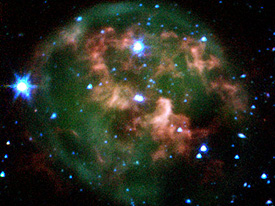 | |  |  |  | A Flash in the Cosmic Pan
|
09.13.04
|
 Like galactic fireworks in the night, gamma-ray bursts briefly light up the stellar sky as only the most powerful explosions in the universe can. Yet as magnificent as gamma-ray bursts are, their fleeting nature makes them elusive and difficult to study. Like galactic fireworks in the night, gamma-ray bursts briefly light up the stellar sky as only the most powerful explosions in the universe can. Yet as magnificent as gamma-ray bursts are, their fleeting nature makes them elusive and difficult to study.
Image to right: Dying stars like the one inside this planetary nebula are a possible source for gamma-ray bursts. Credit: NASA
That's not to say that astronomers don't know anything about them at all. When the Swift spacecraft begins its mission from Cape Canaveral Air Force Station in October, it will be building on nearly 40 years of research and observations.
Gamma-ray bursts are incredibly intense releases of gamma radiation. Found at the highest frequency end of the electromagnetic spectrum, gamma radiation is a particularly energetic form of light that can only be generated by the most powerful astronomical events. Scientists suspect that these sporadic explosions may signal the birth of black holes or the death of stars.
The first gamma-ray bursts were detected in 1967 by the U.S. military's Vela satellites. This fleet of satellites was originally designed to monitor nuclear weapons testing and could sense large releases of gamma radiation. While orbiting the Earth, a Vela satellite recorded a burst of concentrated gamma energy from deep space. For the first time, a gamma-ray burst was observed by humans.
Modern, space-based gamma-ray burst research began in earnest with the 1991 launch of the Compton Gamma Ray Observatory aboard Space Shuttle Atlantis. For nine years, the Compton Observatory searched the sky for gamma-ray activity. In those years in orbit, the observatory made a number of discoveries and mapped thousands of gamma-ray bursts.
In 1997, the Italian Space Agency placed the BeppoSAX satellite in orbit and it made a critical discovery by identifying the lingering X-ray "afterglow" produced by erupting gamma-ray bursts. This finding allowed astronomers to look at the bursts in a new light, and paved the way for the design of new spacecraft like Swift.
Today, the pursuit of gamma-ray bursts continues with the impending launch of the Swift spacecraft. Armed with a trio of telescopes and a network of supporting space-based and ground telescopes, astronomers have managed to set a sophisticated trap that is ready to catch gamma-ray bursts in the act as they light up the night.
Charlie Plain
NASA's John F. Kennedy Space Center
|
|  |
